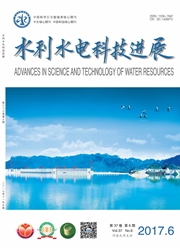

 中文摘要:
中文摘要:
为保障高盐度底泥水库供水氯离子质量浓度达标(小于250 mg/L),在水库闸门工程布置及水库正常运行期间对高盐度底泥这一氯离子释放源对水库水质的影响进行研究。以天津市北塘水库为例,针对水库闸门布置方案比选及水库在运行期间的水质咸化问题,考虑高盐度底泥氯离子释放,建立三维水动力水质模型进行数值模拟。结果表明:引水、供水闸门的空间布置直接影响供水水质,引水闸位于西南角同时开启3个供水闸的方案为较优方案,该方案下基本无死水区域,供水水质在供水8 d后达标;在水库静置期,底泥氯离子释放速率与底泥含盐量呈正相关,在最不利情况下,水库氯离子在底泥释放55 d后浓度超标。
 英文摘要:
英文摘要:
In order to ensure that the chloride ions concentration of the water from a reservoir with high-salinity sediment reaches the standard ( less than 250 mg/L) , the effects of high-salinity sediment, the main source of chloride ions, on the water quality of the reservoir were studied during the periods of layout design of reservoir gates and operation of the reservoir, using the Beitang Reservoir in Tianjin City as an example. To determine the optimal layout of gates from alternative schemes and to simulate the water salinization in the operation period of the reservoir, a three-dimensional hydrodynamic and water quality model was established, with the release of chloride ions from the high-salinity sediment considered. The results show that the water quality is directly influenced by the spatial layout of the inflow and outflow gates. It is put forward that the scheme with the inflow gate located in the southwestern corner and with the three outflow gates open at the same time is the optimal scheme, in which there is nearly no static region and the water quality will reach the standard after eight days. In the static period of the reservoir, the release rate of chloride ions from the sediment is positively correlated with the salt content in the sediment, and the concentration of chloride ions in the reservoir will exceed the standard at the 55th day after the release under the most unfavorable conditions.
 同期刊论文项目
同期刊论文项目
 同项目期刊论文
同项目期刊论文
 期刊信息
期刊信息
